Steven Lyle Jordan's Blog, page 22
June 9, 2016
Washington: What happened to teleworking?
 Washington, DC is in an unusual situation, traffic-wise: Its ageing Metrorail system is in such dire need of repair that sections and entire stations are being shut down for weeks while needed work is done. As a result, hordes of people who normally use the trains for commuting have taken to driving instead, and the resultant daily gridlock is like nothing DC has seen for years.
Washington, DC is in an unusual situation, traffic-wise: Its ageing Metrorail system is in such dire need of repair that sections and entire stations are being shut down for weeks while needed work is done. As a result, hordes of people who normally use the trains for commuting have taken to driving instead, and the resultant daily gridlock is like nothing DC has seen for years.
Many DC residents are aware that the Metro was built inadequately from the beginning, and suffers from constant budgetary battles since its inception, thanks to the purse-strings being handled by the District, two states and the US Congress (and you don’t get more dysfunctional than that). This emergency repair situation is a direct result of that.
But what concerns me the most is the resultant traffic crash, and the fact that we’ve had the tools for years to minimize traffic significantly by allowing most of DC’s desk jockeys to work from home as needed. So my question is: What happened to teleworking? Washington and the surrounding counties are among the most well-connected places in the world, with an embarrassing spectrum of TV, radio, cellphone, wireless, cable and internet feeds and very few holes. With these tools, virtually everyone who rides a desk can do so from the comfort of their living room or den, 24-7-365.
Despite this, most DC desk jockeys either do not telework, or only telework 1-2 days out of the week. My office, for instance, sets a limit on teleworking of 1 day per week. During this traffic crisis, I would’ve expected cries to expand teleworking as far as possible to cut down on the gridlock. But most workers are being told to do that as a last resort; they are still expected to “do what you have to” to get to work and do their jobs.
And gridlock is the result.
The realistic concept of telework has been around for over 2 decades now. About a decade ago, it became relatively easy for anyone in a major metropolitan area to do so. But managers and bosses are still concerned about home-based workers “gold-bricking” on their dime, and trying to figure out how to make sure work is being done.
There are some large companies doing extensive telework; many of them have figured out how to make the process work and keep workers accountable. What I keep expecting to happen is that someone at one of those large companies brings their teleworking manual to Washington (or is asked by someone in Washington to do so), so that manual can be studied by the government and used as a ready-made, tried and tested resource to hand out to all businesses and advise them on its use.
So far, this has not happened. And it’s a shame, because the problems it would mitigate are so clear and obvious: The list just starts with visible traffic and gridlock; and it extends on to time wasted, energy exhausted, pollution increased, people frustrated, productivity lost and profits squandered. On a national level. A working telework system would improve traffic, make workers happy and more productive, make the world cleaner and make companies more profitable.
Not that Washington, DC doesn’t need its Metrorail back to full function—but it’s not the only tool we can use to improve life in the area; and it’s being left in the bottom of the toolbox. Isn’t it about time we took it out and put it to proper use?


June 4, 2016
The triumph of Orphan Black
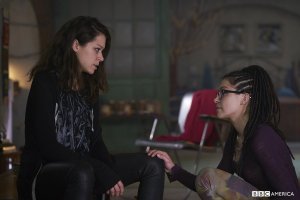
Tatiana Maslany, as Sarah, speaks to Tatiana Maslany as Cosima. From Orphan Black
The more I watch the series Orphan Black, the more I find myself convinced that this may be the most perfect science fiction television series ever.
Why? Actually, the photo at left is so much of why I believe that. Actress Tatiana Maslany has, since the show debuted in 2013, played a series of clones that are the central object of the show—to date, about twelve clone-sisters. But as amazing as even that sounds, it isn’t the most impressive part of Orphan Black.The most impressive single thing about the show is Tatiana’s acting chops. She doesn’t just play different characters (in any episode, at least three of them, often as many as five), but she manages to inbue each character with incredibly distinct looks, personality traits and behaviors. The girls that are prominent to the story—headstrong rebel Sarah, scientists Cosima and Rachel, suburban housewife Alison and trained assassin Helena—can be compared, scene to scene, against each other, and seem so different that it can become impossible to believe that one actress is so effectively creating each of those characters. Add to that a horde of strong characters, possibly the best acting troupe ever assembled in a single SF series, and it’s easy to see why so many awards have been thrown their way.
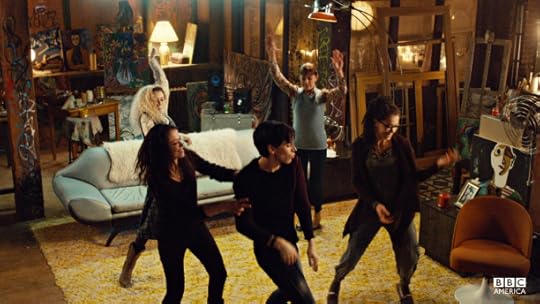
Tatiana Maslany dancing with Tatiana Maslany, Tatiana Maslany, Tatiana Maslany and Jordan Gavaris. They even dance differently!
What helps to make Tatiana’s acting tour-de-force so seamless is the A-list special effects used to combine multiple iterations of her on-set. This show could not have been done twenty years ago, but modern special effects have caught up with the show’s needs today. The special effects teams are masters of an impressive and accomplished trade, and completely sell the idea of multiple identical sestras—ahem, sisters—and the science and technology that supports the premise. And the rest of the cast deals with the multiple-character effects, as well as Tatiana’s various characters, seamlessly as well.
But even that isn’t all. The series encompasses a vast storyline involving 20-year-old cloning experiments, secretive organizations with eugenics agendas, government and private labs, surveillance programs and high-tech hacking, artificial lifeforms, genetic manipulation, social manipulation, personal rights, self-identity, international influences and secret communications. There’s no telling how many clones there are, but the show has hinted at 20 or more. While many clones were aware of their sisterhood, many were not; and most of them have been watched and studied. Some sisters have demonstrated differences in their final genetic makeup, resulting in much investigation and drama between them and the scientists aware of their nature.
They seek to understand their past and work out their future, while hiding their nature from most of the world. And now, with genetic manipulation becoming the new thing, they are considered obsolete and, therefore, disposable. This is a well-developed scientific conspiracy with global reach, touching on the latest in medical science as well as the ramifications of being different, being hunted, and being a member of a unique family.
All of that combines into a TV series with incredibly few peers, fewer flaws, virtually no detractors, and perpetual nominee for a permanent place in any Television Hall of Fame worth its salt (not just a science-fiction-dedicated hall… any hall). At times, all of this literally overwhelms my mind, making it hard to actually sit back and enjoy what I’m watching; every aspect of the show is too fascinating to dismiss. But even when I do manage to put my mind fully into the story, somewhere in a little corner of my head, I think of how much emptier this world will be when this incredible series finally ends.


May 31, 2016
The Rock will become the Man of Bronze… whom he sees as a “weirdo”
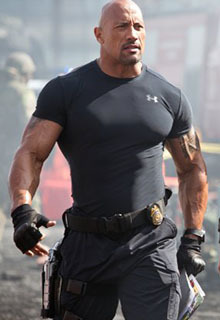 This weekend, Dwayne “The Rock” Johnson posted an Instagram message that he’s agreed to play the pulp hero Doc Savage, the “Man of Bronze,” in the upcoming Shane Black production.
This weekend, Dwayne “The Rock” Johnson posted an Instagram message that he’s agreed to play the pulp hero Doc Savage, the “Man of Bronze,” in the upcoming Shane Black production.
Granted, he’s got the bod for it—though I’m not sure how well he’s going to rock the bronze hair (see what I did there?)—but I’m even more interested to see how he plans to play a character who is, in Johnson’s own words… “A F*CKING HILARIOUS WEIRDO!”
Johnson’s further comments enlighten us: He states that although Doc is a physical and mental master of pretty much everything, he was raised and trained into adulthood on a tropical island by a team of aging scientists, with not a single woman around; and as a result, Doc has the social skills of a—wait for it—rock. That’s apparently how they want to play him: Adept at every task, but hard to communicate with on a personal level.
Which is, in fact, very little like the Doc Savage of the pulps. Doc didn’t have trouble communicating with anyone… because he was all-business, all the time. He wasn’t a social person, it’s true: He didn’t kick back and throw down a few beers with his buddies; he didn’t try to bed the girls he came in contact with; and he generally avoided any female attentions lavished upon him by just busying himself elsewhere. But he didn’t get tongue-tied around women, or struggle to fit in with his comrades. He had the seriousness of Batman, without the flighty playboy alter-ego.
Unfortunately, the Black/Johnson take does fit the modern trend to throw shade on nerds and geeks, to poke fun at them and keep them from fitting in. (I could write a chapter on that.) Clearly Shane and Johnson buy into that… if only to make movies that sell to the largest segment of moviegoers, the ones who can barely walk and chew gum at the same time… but buy boatloads of gum all the same.
So you know that means every discussion with a pretty girl will become a laugh-riot… right? Well, knowing movie-makers, they’ll certainly do everything to make that so. And we’ll have a combination adventure movie and sitcom, with the main character as the straight man to his own gags.
Now, this may work. Lord knows, Harrison Ford’s Indiana Jones made it work. And Shane Black has a stuffed to the gills with quirky characters in action-adventure films. But gags can be taken too far, and I’m crossing my fingers that this team will know when to pull back.
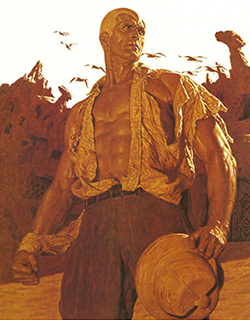 The other issue with this franchise is Doc’s associates. Renny Renwick, Monk Mayfair, Ham Brooks, Long Tom Roberts and Johnny Littlejohn are a pretty unique bunch themselves, and casting them will be tricky—Monk most of all, since he’s supposed to be so short, muscular and homely that he can supposedly be mistaken for a pigmy gorilla in a dark alley. If they screw up with the Fabulous Five, it could ruin the overall project.
The other issue with this franchise is Doc’s associates. Renny Renwick, Monk Mayfair, Ham Brooks, Long Tom Roberts and Johnny Littlejohn are a pretty unique bunch themselves, and casting them will be tricky—Monk most of all, since he’s supposed to be so short, muscular and homely that he can supposedly be mistaken for a pigmy gorilla in a dark alley. If they screw up with the Fabulous Five, it could ruin the overall project.
As for Pat Savage, Doc’s sassy, sexy and statuesque blonde cousin? Okay, I don’t think Hollywood would have a problem filling that role… but honestly, I’d expect them to avoid adding Pat to the movie, as a female lead that Doc can bumble around will be sooo much funnier if it’s not his cousin. I suppose she could still be there, as the stereotypical “female instigator” trying to push Doc into this girl, or give advice on how to land that girl… (I know, I’m not showing a lot of confidence, am I?)
Still and despite all that, it’ll all be worth it to see Dwayne Johnson as Doc. Yeah, I’ll buy a ticket for that, boys.


The Rock will become the Man of Bronze
 This weekend, Dwayne “The Rock” Johnson posted an Instagram message that he’s agreed to play the pulp hero Doc Savage, the “Man of Bronze,” in the upcoming Shane Black production.
This weekend, Dwayne “The Rock” Johnson posted an Instagram message that he’s agreed to play the pulp hero Doc Savage, the “Man of Bronze,” in the upcoming Shane Black production.
Granted, he’s got the bod for it—though I’m not sure how well he’s going to rock the bronze hair (see what I did there?)—but I’m even more interested to see how he plans to play a character who is, in Johnson’s own words… “A F*CKING HILARIOUS WEIRDO!”
Johnson’s further comments enlighten us: He states that although Doc is a physical and mental master of pretty much everything, he was raised and trained into adulthood on a tropical island by a team of aging scientists, with not a single woman around; and as a result, Doc has the social skills of a—wait for it—rock. That’s apparently how they want to play him: Adept at every task, but hard to communicate with on a personal level.
You know that means every discussion with a pretty girl will become a laugh-riot… right? Well, knowing movie-makers, they’ll certainly do everything to make that so. And we’ll have a combination adventure movie and sitcom, with the main character as the straight man to his own gags.
Now, this may work. Lord knows, Harrison Ford’s Indiana Jones made it work. And Shane Black has a stuffed to the gills with quirky characters in action-adventure films. But gags can be taken too far, and I’m crossing my fingers that this team will know when to pull back.
 The other issue with this franchise is Doc’s associates. Renny Renwick, Monk Mayfair, Ham Brooks, Long Tom Roberts and Johnny Littlejohn are a pretty unique bunch themselves, and casting them will be tricky—Monk most of all, since he’s supposed to be so short, muscular and homely that he can supposedly be mistaken for a pigmy gorilla in a dark alley. If they screw up with the Fabulous Five, it could ruin the overall project.
The other issue with this franchise is Doc’s associates. Renny Renwick, Monk Mayfair, Ham Brooks, Long Tom Roberts and Johnny Littlejohn are a pretty unique bunch themselves, and casting them will be tricky—Monk most of all, since he’s supposed to be so short, muscular and homely that he can supposedly be mistaken for a pigmy gorilla in a dark alley. If they screw up with the Fabulous Five, it could ruin the overall project.
As for Pat Savage, Doc’s sassy, sexy and statuesque blonde cousin? Okay, I don’t think Hollywood will have a problem filling that role…
Still, it’ll all be worth it to see Dwayne Johnson as Doc. Yeah, I’ll buy a ticket for that, boys.


May 30, 2016
Not pretty… but it’s working.
This month, the Bigelow Airspace inflatable space habitation module was launched up to the ISS, attached and inflated (after a few slow starts). The module is designed to provide easy-to-add space for crew members, and is envisioned to be part of a “space hotel” assembly that Bigelow would love to put in orbit for us average Joes to visit.
Such a shame, then, that so many people are downplaying the success of the module because… it’s not pretty.
It seems that the public’s perception of science and engineering, especially in space, has been so colored by the incredible movie and TV special effects we’re treated to at all times that, when a proficient and realistically-incredible technical or engineering feat is pulled off, people automatically downplay it. “That doesn’t look like a starship to me.” “Star Trek looks so much better than that.” Etc.
It doesn’t help that our instant-gratification society seems to have no more patience for models, testing or prototyping. “Where’s my flying car?” is now the accepted mantra for demonstrating your impatience in science and technology catering to your needs.
But guys, you have to start somewhere. We are literally taking baby steps beyond our doorstep, severely limited by the miniscule budgets provided our space agencies to allow us to build more rockets, carriers, fighters and drones. These are prototypes… test modules designed to make sure you and I don’t go up there and suffocate, freeze or cook in cosmic radiation.
Yeah, the test module isn’t pretty. But it’s working (so far).
So give ’em some slack, okay?


May 29, 2016
Steven Lyle Jordan
Web designer, Science aficionado, Futurist, Science Fiction fan and advocate of technology, environmentalism and social reform.


December 26, 2015
The last post
This is just a quick note to say that this will be the last post on this blog. I’ll be taking down the blog posts at the end of the year, or thereabouts.
Not to belabor the point, but I started this blog for one primary purpose: To attract customers to buy my books. Put simply, it hasn’t worked. I’ve not seen significant book sales from this blog since it was opened, not even on its best days or highest visitations. As a promotional tool, this blog has been quite literally useless… nothing but an incredible time-sink and waste of effort.
To those (three of) you who will be sorry to lose my commentary on science and science fiction: c’est la vie. My opinions were clearly not entertaining or edifying to enough of an audience. And most importantly, those opinions weren’t being shared very far… and those who read them, whether they liked those opinions or not, were not swayed enough to buy my books.
So, I’m shutting it down, and will be applying my time to more personally satisfying activities. Have a good 2016. See ya.


December 18, 2015
Childhood’s End arises… and lands with a dull thud
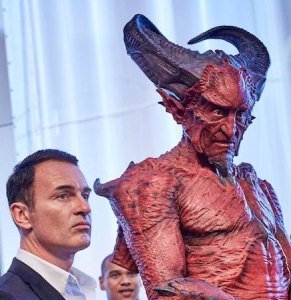 Well, we finally got Syfy’s three-night adaptation of Arthur C. Clarke’s classic novel Childhood’s End. And although Syfy did a better job with it than the first time anyone tried to bring this story to television… at least it looked something like the original story… they still missed the mark with it.
Well, we finally got Syfy’s three-night adaptation of Arthur C. Clarke’s classic novel Childhood’s End. And although Syfy did a better job with it than the first time anyone tried to bring this story to television… at least it looked something like the original story… they still missed the mark with it.
Their end product was a good example of what most television and movie producers think of science fiction… bolstered by the tastes of most of their audience. In hindsight, it’s no wonder we got what we got.
Anyone who’s read Clarke’s original book knows that Childhood’s End was a thoughtful book, about an inevitable evolution of mankind, and the aliens tasked with shepherding the process. Clarke was one of the old school science fiction authors who favored intellectually-balanced stories and scientific concepts. Childhood’s End stands as one of the landmark examples of that type of science fiction.
Which makes it odd that Syfy would want to make a TV adaption of it… because Clarke’s brand of serious science fiction hasn’t played well on television, or the movies, in years.
With very few notable exceptions—Person of Interest on TV comes to mind, as well as Ex Machina and The Martian in theaters—cinematic and broadcast science fiction has played best to an audience that has demonstrated that they have no interest in science. Even Star Trek, once a series that espoused the latest in scientific theory and the honest exploration of the galaxy, has performed best in recent years when it threw all of that out the window and concentrated on fighting and blowing stuff up. Most of that was due to the influence of Star Wars, all the way back in 1977, a movie that used the tropes and trappings of a science fiction movie as mere window dressing for a fantasy adventure romp. And it made big enough boatloads of money for every TV and movie producer to try to duplicate Star Wars‘ non-science sci-fi thunder.
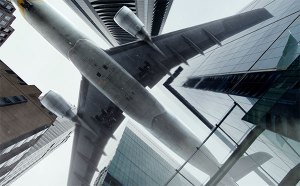 The signs are there in Childhood’s End: Clearly the producers looked at the story and said, “Yeah… but it needs punching up.” The added visual gags, like jumbo jets floating serenely down onto city streets, Stormgren’s home disassembling itself stick by stick (and reassembling itself), and the now-ubiquitous “bullet-time” shot in the terrorists’ lair, were clear attempts at adding visual spice to the story.
The signs are there in Childhood’s End: Clearly the producers looked at the story and said, “Yeah… but it needs punching up.” The added visual gags, like jumbo jets floating serenely down onto city streets, Stormgren’s home disassembling itself stick by stick (and reassembling itself), and the now-ubiquitous “bullet-time” shot in the terrorists’ lair, were clear attempts at adding visual spice to the story.
As well, the producers couldn’t accept the idea of the Overlords looking like the penultimate Devils of old, and not actually being evil. In Clarke’s novel, it was clear that the Overlords had no animosity toward Mankind; in fact, not only were they very friendly and polite towards humans, but they had an intense curiosity about human history, especially in subjects of the occult… specifically, to try to figure out how an event happening in Man’s far future could cause psychic reverberations that would reach all the way back to Man’s distant past. The Overlords of the novel were carrying out another’s orders, and had absolutely no say in the matter; they merely did what they could to make sure man didn’t destroy himself before its time.
The TV adaptation kicked that to the curb, and instead presented the Overlords as manipulative and intentionally complicit in the stagnation of Humanity. In addition, newly-minted characters like Perrera represented the religious right in denouncing the Overlords and their actions, with her words making them appear even more devious. Clearly, the producers wanted the audience to see the Overlords as evil, serving a greater evil, and shepherding the destruction of Mankind… the exact opposite of the actual intent of the novel, with the Overlords providing as comfortable an Endtime as possible, while Man’s children “graduated” to a new level of beings and took their place among the stars.
Needless soap-opera nonsense was also added to the miniseries: Conflict between Stormgren, his wife and the ghost of his previous lover; turning Jan Rodricks, a comfortable son of an entertainer and a college professor, into Milo, a smart but crippled ghetto boy living with his junkie mother; adding a pointless love interest for Milo, a colleague doomed to waste her time pining for him while he obsessed on the Overlords; and changing Rupert Boyce, a man highly interested in the occult himself, into a manipulative jerk conspiring with Karellen in a singularly stupid sequence to send signals into space with a futuristic ouija board and the unwitting help of the mother of an unborn “special” child.
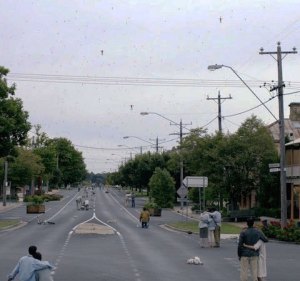
We’re gonna need a lot of milk cartons.
Stripped away are the very notions of a real evolution of the species, a change from the corporeal existence of today’s Man into a new life form for the stars. This was the meat of the original story, that Man is merely a stepping stone in the development of a completely new and advanced entity. Also gone is the message that our knowledge, and even the greater knowledge of the Overlords, is nothing compared to what’s out there; that as we my be ants to the Overlords, the Overlords themselves are bacteria, nay, proteins, compared to the Overmind. Watching the children ascend into the sky, still individual and fully clothed as if being taken by some skybound kidnapper, only leaves the impression that they have not evolved, but have merely been stolen, leaving us the bleak future given to parents of a missing child.
The result was a program (sloppily) designed for a modern audience, degrading the zeitgeist of the original story from a deep philosophical exploration to a low-grade supernatural horror flick.
Personally, I think the wrong director was the problem here. If, say, Alex Garland, director of Ex Machina, had been at the reins of this project, he would have been able to preserve the essence of the story, as well as use the original elements in ways that would have heightened the existing drama and accentuated the otherworldliness of the Overlords, the existential dread of unstoppable evolution, and the devastation of the loss of the children… without the jump-cut scares, soap opera dialogue and wooden character types added to this feature. As it is, this presentation has left behind a high-pitched whirring noise somewhere in the background… it’s Arthur C. Clarke, spinning like a dynamo in his grave.
Syfy has done much better with other literary adaptations, particularly those stories that were more space opera in nature; their version of Dune was notably superior, and they have (so far) done a much better job with The Expanse. But they clearly don’t have the hang of taking an intellectual story and “jazzing it up” for modern audiences; Childhood’s End has become an example of what not to do with serious science fiction literature, if you want to keep any of its intelligence intact. Hopefully Syfy will stick with less intelligent fare in the future, and stick to what they know: Spectacle, melodrama, monsters and blowing stuff up.


December 15, 2015
Not. Happy.
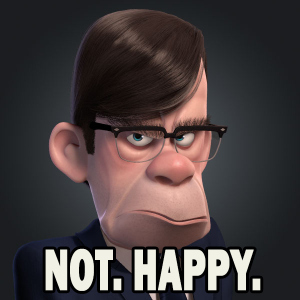 Really, I think it’s a combination of things: NPR puts out an article about the “trendiness of hard science fiction”—as the world goes batshit over the latest Star Wars movie; the Star Trek trailer comes out, and it looks exactly like you’d expect from the director of The Fast and the Furious; and on the same day that SyFy is bringing an enduring classic, Childhood’s End, to the screen, the webs are abuzz with the trailer for the second-biggest ripoff of Arthur C. Clarke’s masterwork, Independence Day II (the clouds are supposed to obscure the fact that Will Smith isn’t there).
Really, I think it’s a combination of things: NPR puts out an article about the “trendiness of hard science fiction”—as the world goes batshit over the latest Star Wars movie; the Star Trek trailer comes out, and it looks exactly like you’d expect from the director of The Fast and the Furious; and on the same day that SyFy is bringing an enduring classic, Childhood’s End, to the screen, the webs are abuzz with the trailer for the second-biggest ripoff of Arthur C. Clarke’s masterwork, Independence Day II (the clouds are supposed to obscure the fact that Will Smith isn’t there).
Add that to a not-so-great day at work, resulting in my leaving late, getting rained on halfway to the station, and almost coming down with a cold hours later. Plus forgetting my tire pump, forcing me to ride on half-flat bike tires, making the trip harder and more hazardous.
All of this left me in a lousy mood by the time the first night of Childhood’s End came on. And I’m fully prepared to chalk up my dissatisfaction with said lousy mood. But the fact remains that I’ve watched it… and I’m not happy. Before I go any further, I will point out here that I’ve read Childhood’s End, and it’s one of my favorite novels. So, again, I am prepared to accept that I’m over-reacting to what I’ve seen in the first night. But I have to get this off of my chest, so I’m just gonna lay it out.
Now, I get that Childhood’s End was a book, written in the years before we’d even reached the Moon. The international science fiction reading audience of then was very different than the USA television audience of today, and the (expletive deleted) they have largely been raised on. So I get that the producers would want to make changes to the story, to make it more palatable to those audiences.
Hence, the arrival of the Overlord’s ships—impossibly large, like the originals, but now also weirdly-shaped and sporting random strings of white lights and nasty red-glowing radiators—are presaged by every aircraft in the world suddenly ceasing to fly… a rather over-the-top presentation of jets floating slowly out of the air and landing in cornfields and city streets… like there was some reason they couldn’t finish their journey unassailed. Which there was not. You’d think the arrival of the massive ships would be enough, and in truth, the majesty and shock of seeing the ships themselves was nicely done. But no: Let’s throw in floating jetliners in Manhattan, too… won’t that be cool?
Next, let’s replace the original liaison with the Overlords, a United Nations executive, because who cares about stuffy old men in the UN? What is the UN? Who shall we get, to represent the interests of the entire world? I know: a straight-talking American farmboy-slash-male model whose claim to fame is charming the pants off of his local yokels in the midwest. Yeah, he’ll be a hit in the Sudan. And we’ll send a probe that rather uber-dramatically takes his house apart, literally stick by stick, to convince him to come outside. Subtle as a supernova, these Overlords.
Next, let’s give a substantial voice to the paranoid xenophobes who we know will come out of the woodwork. Everybody hates media moguls today; so let’s have a Rupert Murdock stand-in who can sound ominous and asinine at the same time. And instead of the head of the terrorists being essentially pacifist, and non-threatening to Stormgren… let’s have our mogul decide to just shoot Stormgren, because he’s not on our side, so (shrug) why the hell not? And it gives us a great excuse to do some bullet-time effects to save our male model from getting his hair mussed.
And then… there’s Milo.
Okay, I’ll be frank (no, never mind, I’ll just be Steve)—Milo’s character is pushing buttons in me that very rarely get pressed. Personally, I think some people press stomp these buttons so often that maybe I’m just getting weary of them. But in this case, I have to speak up.
First: Milo’s name in the book was Jan Rodricks. So, maybe Jan is a bit out-of-favor for male names today. But the producers could have named him John, Paul, George or Ringo… and any number of other names to sound more modern. Instead, they give him Milo… which, don’t ask me why, seems to be one of those names that has become synonymous for certain racial backgrounds. Or, to put it another way, with a name like Milo… could he be anything but Black? (I’m so surprised that they didn’t rename him Jefferson.)
Second: The Jan in the book was the son of a divorced Scots magician from Haiti and a Black college professor from Scotland. He was not introduced in the first part of the story at all; he didn’t appear until a third of the way along, when the Overlords had already made sure everyone in the world was living comfortably. He was of average intelligence, he grew up with a sister, Maia, and when he left college, he dreamed of going to the stars.
On TV, the renamed Milo is introduced early on, as a preteen boy of better than average intelligence, in a wheelchair, living in the ghetto with his poor but kindhearted junkie mother, and hanging out with an old Black man who lives in his dead car in an empty lot. His defining moment in the first episode is being shot by his mom’s pusher for insulting him after mom is pistol-whipped by him.
WHAT THE GOD’S HONEST FUCK, MAN.
I mean, are we really resorting to these old racist tropes to depict the singular Black characters in this story? Did the producers just walk out of an Amos and Andy screening, or perhaps they’ve been hanging out too long with Donald Trump, and honestly believe this is the way the average American Black family must be depicted to get the audience’s interest? This is the enlightened age I’m supposed to believe I live in? I feel like I was just hit with the oldest surviving race stick in the collection, the one conservatives keep mounted on their mantle to remind them of the Good Old Days.
At this point, I am forced to remember the first time Childhood’s End was optioned for television, back in the seventies. After the producers got through messing with it, we ended up with… V.
And I swear, I’m not feeling much more optimistic about this new version at this point.


December 12, 2015
Trek-colored glasses
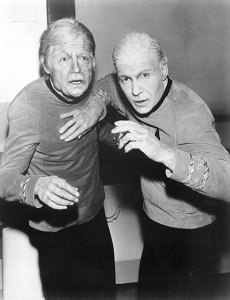 I’ve received a number of comments about my post describing how Star Trek is as out-of-date today as Buck Rogers was in 1980.
I’ve received a number of comments about my post describing how Star Trek is as out-of-date today as Buck Rogers was in 1980.
Most of it negative.
Many of the commenters clearly didn’t read beyond the title of the article. Or they read further, but the only thing they got out of it was my saying “Star Trek drools!” (Which—ahem—I never said.) Then they sought to beat back my argument… thereby missing my point by a light-year.
It’s no mystery why this happened: One of the most incredible things about Star Trek is that its popularity has, over the years, made it a subject of nostalgia and romance, among aficionados and among people who just fondly remember it from their past… putting it in the company of such shows as The Twilight Zone, Bonanza, All In The Family and M*A*S*H*. It’s become an icon itself, a demi-god of a show that everyone looks up to overall, even beyond its obvious imperfections. It has become essentially unassailable, science fiction television’s indomitable father-figure, the revered bust on the mantle, Teddy Roosevelt.
You know what? It deserves to be all of those things. And I never said it wasn’t.
What I said was: Star Trek is fifty years old. But our knowledge of technology, physics and the nature of the universe has changed a lot in those fifty years. And as good as Star Trek was, it’s really no longer the best vehicle to present a modern science fiction exploration show, because the show concept is based on a fifty year old understanding of science, space and television itself.
So we’re crystal clear on what I’m saying, let’s go over a few details, and you’ll understand where I’m coming from.
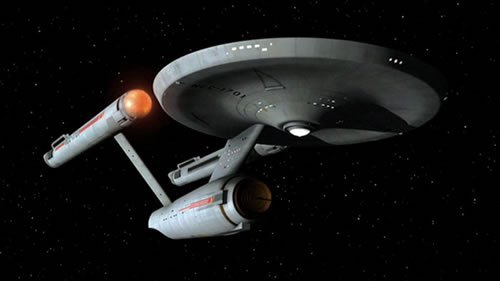 Star Trek was created in the early 1960s. At the time, we were in a Cold War, the Russians had put a satellite in orbit, we’d seen innumerable cheap movies about weird aliens swooping down and trying to conquer Earth, and strange creatures borne of atomic testing and radiation exposure accidents. Television audiences were enjoying I love Lucy, starring a woman who would soon give the green light for a new series that was to be a “Wagon Train to the stars,” alluding to a popular western show with a premise of a group of people traveling the space frontier, dealing with their own problems and helping people along the way.
Star Trek was created in the early 1960s. At the time, we were in a Cold War, the Russians had put a satellite in orbit, we’d seen innumerable cheap movies about weird aliens swooping down and trying to conquer Earth, and strange creatures borne of atomic testing and radiation exposure accidents. Television audiences were enjoying I love Lucy, starring a woman who would soon give the green light for a new series that was to be a “Wagon Train to the stars,” alluding to a popular western show with a premise of a group of people traveling the space frontier, dealing with their own problems and helping people along the way.
Got that? Star Trek was a space western. It was conceived by Gene Roddenberry, a man who had served as a pilot in World War II, then after the war as a policeman, and shared traditional American values of Democracy and Christianity. He created Trek for an American audience that was raised on war shows, westerns, detectives, sitcoms and soap operas, then toned it down and colored it up for television executives who thought it was “too cerebral” for those audiences.
Just as we had shows about people who would visit new places and meet strange people every week, television audiences were willing to entertain the notion that we’d be able to fly to new planets and meet strange aliens… just a lot faster, since space was so big. Despite the fact that scientists, led by a guy named Einstein, told us that there was no way to travel faster than light, Roddenberry decided the ship would go faster than light anyway, so his space “Wagon Train” could be at a new planet every week.
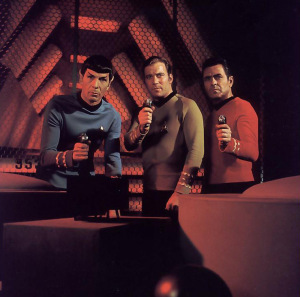 In order to make the show pretty and save production money, Roddenberry and his crew invented things out of whole cloth—things that looked and sounded futuristic and cool to technologically unsophisticated 1960s audiences—and he didn’t worry about whether or not they were actually possible. The transporter, for instance, was created in order to avoid the costly special effects of landing a ship model on a planet every week. He didn’t worry about the realistic fact that solving the engineering problems required to create a device capable of breaking down the atoms of a person, “beaming” them to another location and reassembling them perfectly at the other end were a hella bigger than solving the problem of landing space ships on planets. He also renamed elements with techy-sounding labels, like “di-lithium,” “tri-tanium,” “quatro-triticale,” etc, to make the things we’ve heard of in real life sound… well, more futuristic, and better. And he conceived of incredible power advances, enough to push a starship faster than light, enough to pump raw energy at other ships and destroy them, enough to cause an overloading hand weapon to be able to explode and devastate a large room.
In order to make the show pretty and save production money, Roddenberry and his crew invented things out of whole cloth—things that looked and sounded futuristic and cool to technologically unsophisticated 1960s audiences—and he didn’t worry about whether or not they were actually possible. The transporter, for instance, was created in order to avoid the costly special effects of landing a ship model on a planet every week. He didn’t worry about the realistic fact that solving the engineering problems required to create a device capable of breaking down the atoms of a person, “beaming” them to another location and reassembling them perfectly at the other end were a hella bigger than solving the problem of landing space ships on planets. He also renamed elements with techy-sounding labels, like “di-lithium,” “tri-tanium,” “quatro-triticale,” etc, to make the things we’ve heard of in real life sound… well, more futuristic, and better. And he conceived of incredible power advances, enough to push a starship faster than light, enough to pump raw energy at other ships and destroy them, enough to cause an overloading hand weapon to be able to explode and devastate a large room.
Roddenberry combined all that made-up stuff with realistic extrapolations of some technologies, like sensors, recorders, displays and control systems, to help blur the line between possibly and fantasy. It provided an acceptable backdrop to the stories of exciting battles, strange worlds and exploration of the human condition that all mirrored the realities of the world in the 1960s. In a way, it was the flip side of the coin that gave us The Twilight Zone; but where Twilight Zone gave you morality tales and told you up front, “this is just fantasy, folks,” Star Trek gave you the same stories but told you, “this could really happen.”
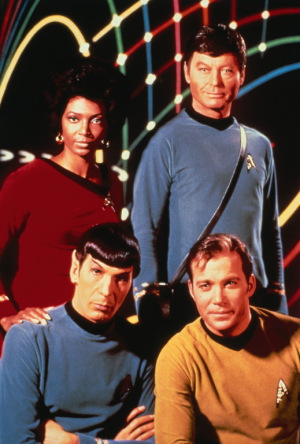 Largely due to Roddenberry’s past in the military, he also decided to build the show around a military organization, patterned after a modern naval vessel and its crew. His starship Enterprise was manned with hundreds of professionals, each working specialized jobs and reporting to the Captain and his officers, engaging in military-themed battles with other ships, and sending landing parties to newly-visited planets. This was also very familiar to 1960s TV audiences, which had grown up watching wartime dramas on TV and in the movies, and provided that additional grounding to the present that audiences needed. And the aliens of Star Trek were simply patterned after caricatures of various nationalities or social groups also familiar to television audiences, making the “visiting new lands planets, meeting new peoples aliens” element easily relatable. Audiences of the time didn’t really know for a fact that there wouldn’t be Earth-like planets peppering the galaxy, nor that aliens would not likely look like us… so they were prepared to suspend their disbelief and go with it.
Largely due to Roddenberry’s past in the military, he also decided to build the show around a military organization, patterned after a modern naval vessel and its crew. His starship Enterprise was manned with hundreds of professionals, each working specialized jobs and reporting to the Captain and his officers, engaging in military-themed battles with other ships, and sending landing parties to newly-visited planets. This was also very familiar to 1960s TV audiences, which had grown up watching wartime dramas on TV and in the movies, and provided that additional grounding to the present that audiences needed. And the aliens of Star Trek were simply patterned after caricatures of various nationalities or social groups also familiar to television audiences, making the “visiting new lands planets, meeting new peoples aliens” element easily relatable. Audiences of the time didn’t really know for a fact that there wouldn’t be Earth-like planets peppering the galaxy, nor that aliens would not likely look like us… so they were prepared to suspend their disbelief and go with it.
And for that relatively unsophisticated 1966 audience, it all worked. Star Trek was such an imaginative and well-conceived package, the future (and the fantasy) smoothly intersected with the familiar, combined with highly-relevant stories about the burning social and political issues of the 1960s, and wrapped into an episodic show format, that it captured the imaginations of worldwide fans like few shows before it ever had.
So, let’s fast-forward 49 years—half a century—to 2015. In 2015, we are no longer in a Cold War (we are now embroiled in worldwide terrorist incidents). We’ve been to the Moon, and plan to go someday soon to Mars and begin prospecting the asteroid belt. But we haven’t heard from any aliens, and as we’ve learned from deeper examination of the life forms on this planet, we have less of an expectation that intelligent beings will by necessity look just like us. And our experiments to communicate with our intelligent neighbors, the ceteceans, has proven that mastering an alien language will be a lot tougher than we thought.
We’ve found a few Earth-like planets out there. When I say Earth-like, I mean planets that we know are at a distance from their star that allows the existence of liquid water, an element we consider vital for life. At least, the kind of life we’re familiar with on Earth. Except that we’re already discovering organisms that can live in inhospitable cold and heat, and creatures that can survive the rigors of open space… showing us that life is a lot more variable than we thought. And those planets: Many of them are so large as to crush us if we tried standing on it, or may not have the electromagnetic field that protects us from solar rays, or… yes, not even the definition of “Earth-like planet” is what we thought it was. There aren’t likely to be too many places where people will be able to arrive, stand, breathe the air and converse with friendly aliens.
But we do know about the theory of terraforming. Maybe we can find ways to make the planets we want, or redesign existing planets (hopefully without indigenous life) to be hospitable to us. Or maybe it makes more sense to build stations in orbit above planets that can provide needed resources, even if we can’t live on them. Life in the future in space should be very different than we expected in 1966.
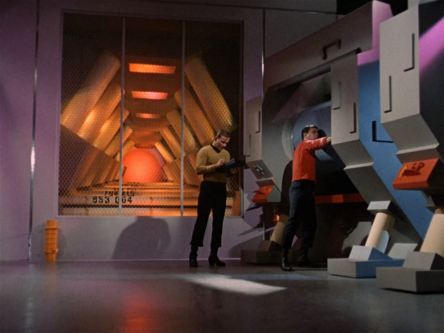 Science now teaches us that mixing matter and antimatter won’t provide the massive energy surge we thought, negating the likelihood of using that power for propulsion or energy-based weapons. We also haven’t figured out how anyone or anything can create shaped electromagnetic fields that can bend time and space and create reality-breaking bubbles for us to travel within. Pushing a giant ship rapidly from place to place is just not realistic, given what we know about space, science and physics today. And things like artificial gravity and inertial dampeners? Invented to make television shows look good and keep your cast from having to wear wires all day. Ask a scientist or engineer how we build them, and they’ll just laugh.
Science now teaches us that mixing matter and antimatter won’t provide the massive energy surge we thought, negating the likelihood of using that power for propulsion or energy-based weapons. We also haven’t figured out how anyone or anything can create shaped electromagnetic fields that can bend time and space and create reality-breaking bubbles for us to travel within. Pushing a giant ship rapidly from place to place is just not realistic, given what we know about space, science and physics today. And things like artificial gravity and inertial dampeners? Invented to make television shows look good and keep your cast from having to wear wires all day. Ask a scientist or engineer how we build them, and they’ll just laugh.
Computers, once the size of auditoriums, and in 1966 large enough to pack a cafeteria space, now fit in our pockets and can automate tasks we never thought possible. Scientists still tell us we can’t go faster than light, so plying the galaxy like a ship cruising the Caribbean is pretty much out of the question. A ship in space isn’t likely to need a few hundred crewpersons to keep it flying, the way a modern naval vessel needs hundreds of people to operate; a small team of specialists, a good computer system and a few well-designed robots would do the same job.
Even television has changed: Episodic shows like the original Star Trek, that essentially resets everything at the end of the program, are passé; audiences like shows and characters that morph, grow, change, and even die, as the series progresses. Shows don’t have to be watched once a week… audiences can record shows to watch whenever it pleases them, including all at once. And shows are available in online venues, allowing viewers to consume it at their television, or at a computer, tablet, even a cellphone. All of this allows shows to better target their desired audiences, and to present a more flexible, realistic and comprehensive entertainment that audiences of fifty years ago could scarcely conceive.
The whole point of this is to demonstrate that the Starship Enterprise is flying on ideas conceived of in the 1960s, by people who had to further bend the rules to deal with television executives whose idea of sophisticated television was Route 66 and Days of Our Lives, and who never would have entertained the idea that a TV show should have a science adviser to keep it honest.
The reality of today is that professional scientists, physicists and academics not only watch these shows, but are actually paid by the shows to keep them real. The audiences are much more sophisticated as well, and know a lot better when they’re being pandered to by clueless producers and walked through a set by out-of-touch actors.
And please take note that at no time did I suggest that the idea of exploring the unknown and examining the human condition, the story premise upon which Star Trek was based, is a pointless or obsolete notion. Rather, it’s what we explore and how we explore it that’s changed so much in fifty years. A new show that truly nails that original premise, in a science fiction format, should be doing it within the latest knowledge of science and physics that we have, in order to not be laughed out of the quadrant.
And I’m sorry, but Star Trek is no longer the cutting-edge science fiction show that it was in 1966. Those who believe it is still that cutting-edge, relevant show, are viewing it through the Trek-colored glasses of nostalgia and romance for a scientific era, and the show that depicted it, now 50 years past.
There are a lot of ideas that can alter or substitute for Star Trek‘s setting and science, and still be an exploration and science show. Firefly set its stories within one solar system of many terraformed planets and moons. The Battlestar: Galactica reboot gave us a way to travel from system to system that, frankly, is more likely to be workable than pushing giant ships around (and they did it in a non-episodic, serial format). Gene Roddenberry’s Andromeda showed us a military vessel that was effectively controlled by a half-dozen people, assisted by the ship’s intelligence and robot drones. There are novels out there (including some of my own) that present a more realistic future, and have the potential to be a great basis for an exploration and science show. Find one you like and run with it.
But we do not have to stick with a show that, great as it was, was conceived during the Cold War by a visionary World War II veteran, and shaped by Mad Men more intent on selling laundry detergent than thinking about science. In 2015, we can do better. We should do better.
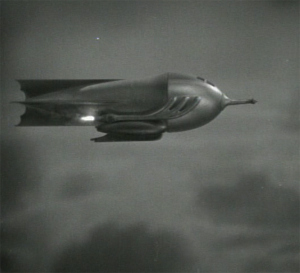
The “cutting edge” of 1936: a Buck Rogers rocketship.
Finally, think about the last post again, and my comparison of Star Trek and Buck Rogers. When Buck first came out in the late 1930s, it was considered the height of adventure science fiction in the movies; when everyone used to reference science and futuristic technology, they called it “that Buck Rogers stuff.” In its day, it was the icon of science and technology. But when Star Trek came out, thirty years later in 1966, Buck Rogers paled embarrassingly by comparison, and found itself completely eclipsed by the new guys on the block; now popular discussions about futuristic science and technology were referred to as “that Star Trek stuff.” (Ten years later, a new movie came along, and the popular lexicon took to calling futuristic science and technology “that Star Wars stuff.”)
It’s almost 2016, fifty years after Star Trek; and we are at the cusp of another such moment, when a new science fiction show can come along and be so far beyond the shows of the past as to become the new icon, the popular touchstone of futuristic science and technology. Imagine a show so modern, so advanced, so thought-provoking and cool, that Star Trek (and Star Wars) actually pales in comparison.
Don’t you want to see that? I know I do. Let’s lay aside our Trek-colored glasses, and look to the future.







